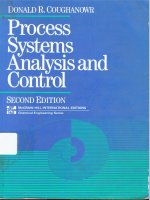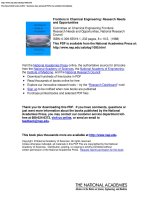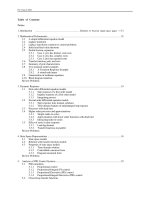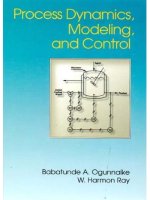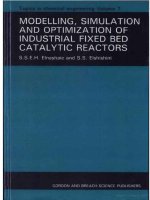process dynamics modeling and control topics in chemical engineering
Bạn đang xem bản rút gọn của tài liệu. Xem và tải ngay bản đầy đủ của tài liệu tại đây (25.56 MB, 1,281 trang )
process
dynamics,
mo de lin g,
an d control
TOPICS IN CHEMICAL ENGINEERING
A Series of Textbooks and Monograph s
SERIES EDITOR
ASSOCIATE EDITORS
KEITH E. GUBBINS
Cornell University
MARK A. BARTEAU
University of Delaware
KLAVS F. JENSEN
Massachusetts Institute of Technology
DOUGLAS A. LAUFFENBURGER
University of lllinois
MANFRED MORARI
California Institute of Technology
W. HARMON RAY
University of Wisconsin
WILUAM B. RUSSEL
Princeton University
SERIES TITLES
Receptors: Models for Binding, Trafficking, and Signalling
D. Lauffenburger and f. Lindennan
Process Dynamics, Modeling, and Control
B. Ogunnaike and W. H. Ray
process
dynamics,
modeling,
and control
BABATUNDE A. OGUNNAIKE
E. I. DuPont de Nemours,
Experimental Station,
and
Adjunct Professor,
Department of Chemical Engineering
University of Delaware
W. HARMON RAY
Department of Chemical Engineering
University of Wisconsin
New York Oxford
OXFORD UNIVERSITY PRESS
1994
Oxford University Press
Oxford New York
Athens Auckla nd Bangkok Bombay
Calcutt a Cape Town Dares Salaam Delhi
Florence Hong Kong Istanbu l Karachi
Kuala Lumpu r Madraa Madrid Melbourne
Mexloo City Nairob i Paris Singap ore
Taipei Tokyo Toront o
and aasoda ted compan ies in
Berlin Ibadan
Copy right@ 1994 by Oxford University Press, Inc.
Publish ed by Oxford Univer sity Press, Inc.,
200 Madiso n Avenue , New York, New York 10016
Oxford is a registe red tradem ark of Oxford Unlvem
ty Press
All righta reserve d. No part of this publica tion
may be reprodu ced,
stored In a retrieva layatem , or transm itted, In
any form or by any means,
electronic, mec:hanlcal, photoco pying, reoordlng,
or othenv lae,
withou t the prior permis sion of Oxford Univer
sity Press.
Ubrary of Congress Cataloglng-ln-Publlcalion
Data
Ogunn alke, Babatu nde A. (Babatu nde Ayodeji)
Proceas dynami cs, modeli ng, and contro l/
Babatu nde A Ogunnllike, W. Harmo n Ray.
p. em. -(Topi cs in chemical enginee ring)
Includes Indexes.
1SBN 0-19-509119-1
1. Chemic al process control.
I. Ray, W. Harmo n (Wiilis Harmo n), 1940U. Title. m. Series: Topics In chemical enginee
ring
(Oxford Univer sity Press)
TP155.75.036 1994 660'.2815---dc20 94-28307
1 3 5 7 9 8 6 4 2
Printed in the United States of America
on add-fre e paper
To Anna and "the boys" (Damini and Deji),
... Agbaja owo ni n'gberu d'ori;
and
To decades of superb graduate student teachers,
... the heart of process control at Wisconsin.
CCONTJENTS
part I
INTRODUCTION
Chapter 1. Introductory Concepts of Process Control
1.1
1.2
1.3
1.4
1.5
1.6
The Chemical Process
An Industrial Perspective of a Typical Process Control Problem
Variables of a Process
The Concept of a Process Control System
Overview of Control System Design
Summary
Chapter 2. Introduction to Control System Implementation
2.1 Introduction
2.2 Historical Overview
2.3 Basic Digital Computer Architecture
2.4 Data Acquisition and Control
2.5 Some Examples
2.6 Summary
vii
5
5
8
13
15
19
30
35
35
36
38
46
56
61
viii
CONTEN TS
par tll
PROCE SS DYNAMICS
Chapter 3. Basic Elements of Dynamic Analysis
3.1
3.2
3.3
3.4
3.5
Introduction
Tools of Dynamic Analysis
The Laplace Transform
Characteristics of Ideal Forcing Functions
Summary
Chapter 4. The Prcxess Model
4.1
4.2
4.3
4.4
4.5
4.6
4.7
4.8
4.9
The Mathematical Description of Chemical Processes
Formulating Process Models
State-Space Models
Transform-Domain Models
Frequency-Response Models
Impulse-Response Models
Interrelationships between Process Model Forms
The Concept of a Transfer Function
Summary
Chapter 5. Dynamic Behavior of Linear Low Order-Systems
5.1
5.2
5.3
5.4
5.5
5.6
First Order Systems
Response of First-Order Systems to Various Inputs
Pure Gain Systems
Pure Capacity Systems
The Lead/La g System
Summar y
Chapter 6. Dynamic Behavior of Linear Higher Order Systems
6.1
6.2
6.3
6.4
6.5
6.6
6.7
Two First-Order Systems in Series
Second-Order Systems
Response of Second-Order Systems to Various Inputs
N First-Order Systems in Series
The General Nth-Order System
Higher Order Systems with Zeros
Summary
67
67
68
71
80
86
89
89
92
104
108
110
111
115
128
134
139
139
142
153
157
161
166
175
175
183
188
200
204
205
211
ix
CONTENTS
Chapter 7. Inverse-Response Systems
225
225
7.1 Introduction
229
7.2 Inverse Response in Physical Processes
7.3 Dynamic Behavior of Systems with Single, Right-Half Plane
231
Zeros
7.4 Dynamic Behavior of Systems with Multiple, Right-Half
237
Plane Zeros
240
7.5 Summary
Chapter 8. Time-Delay Systems
8.1
8.2
8.3
8.4
8.5
8.6
8.7
An Introductory Example
The Pure Time-Delay Process
Dynamic Behavior of Systems with Time Delays
The Steam-Heated Heat Exchanger
Rational Transfer Function Approximations
Model Equations for Systems Containing Time Delays
Summary
Chapter 9. Frequency-Response Analysis
9.1
9.2
9.3
9.4
9.5
9.6
Introduction
A General Treatment
Low-Order Systems
Higher Order Systems
Frequency Response of Feedback Controllers
Summary
VChapter 10.
10.1
10.2
10.3
10.4
10.5
,' Chapter 11.
11.1
11.2
11.3
11.4
11.5
11.6
245
245
249
252
257
261
265
267
275
275
277
288
295
305
306
Nonlinear Systems
311
Introduction: Linear and Nonlinear Behavior in Process
Dynamics
Some Nonlinear Models
Methods of Dynamic Analysis of Nonlinear Systems
Linearization
Summary
312
313
314
320
326
Stability
333
Introductory Concepts of Stability
Stability of Linear Systems
Stability of Nonlinear Systems
Dynamic Behavior of Open-Loop Unstable Systems .
Stability of Dynamic Systems under Feedback Control
Summary
333
337
343
349
353
355
X
CONTENTS
partlll
PROCESS MODELING AND IDENTIFICATION
Chapter 12.
12.1
12.2
12.3
12.4
12.5
12.6
Chapter 13.
13.1
13.2
13.3
13.4
13.5
13.6
13.7
Theoretical Process Modeling
363
Introduction
Development of Theoretical Process Models
Examples cf Theoretical Model Formulation
Parameter Estimation in Theoretical Models
Validation of Theoretical Models
Summary
363
366
368
380
399
401
Process Identification: Empirical Process Modeling
409
Introduction and Motivation
Principles of Empirical Modeling
Step-Response Identification
Impulse-Response Identification
Frequency-Response Identification
Issues for Multivariable Systems
Summary
409
412
417
422
436
447
450
xi
CONTENTS
part IV
PROCESS CONTROL
PART IVA:
Chapter 14.
14.1
14.2
14.3
14.4
14.5
14.6
14.7
14.8
Chapter 15.
15.1
15.2
15.3
15.4
15.5
15.6
15.7
Chapter 16.
16.1
16.2
16.3
16.4
16.5
Chapter 17.
17.1
17.2
17.3
17.4
17.5
SINGLE-WOP CONTROL
Feedback Control Systems
461
The Concept of Feedback Control
Block Diagram Development
Classical Feedback Controllers
Closed-Loop Transfer Functions
Closed-Loop Transient Response
Closed-Loop Stability
The Root Locus Diagram
Summary
461
464
467
468
472
486
496
504
Conventional Feedback Controller Design
513
Preliminary Considerations
Controller Design Principles
Controller Tuning with Fundamental Process Models
Controller Tuning using Approximate Process Models
Controller Tuning using Frequency-Response Models
Controller Tuning without a Model
Summary
513
519
525
532
541
555
557
Design of More Complex Control Structures
565
Processes with Significant Disturbances
Processes with Multiple Outputs Controlled by a Single
Input
Processes with a Single Output Controlled by Multiple
Inputs
Antireset Windup
Summary
565
581
(~8~)
585
586
Controller Design for Processes with Difficult Dynamics
599
Difficult Process Dynamics
Time-Delay Systems
Inverse-Response Systems
Open-Loop Unstable Systems
Summary
599
603
608
617
619
xii
CONTE NTS
Chapt er 18.
18.1
18.2
18.3
18.4
18.5
Chapt er 19.
19.1
19.2
..J ~
19.4
19.5
19.6
Contro ller Design for Nonlin ear Systems
625
Nonlin ear Contro ller Design Philos ophies
Linear ization and the Classical Appro ach
Adapt ive Contro l Princi ples
Variab le Transf ormati ons
Summ ary
625
626
628
632
638
Model-Based Contro l
645
Introduction
Contro ller Design by Direct Synthesis
Intern al Model Contro l
Generic Model Contro l
Optim ization Appro aches
Summ ary
645
648
665
671
674
675
PAR T IVB: MUL TIVA BIAB LE PRO CESS CON TROL
Chapt er 20.
20.1
20.2
20.3
20.4
20.5
20.6
Chapt er 21.
21.1
21.2
21.3
21.4
21.5
21.6
21.7
21.8
21.9
21.10
Introd uction to Multiv ariable System s
The Nature of Multiv ariable System s
Multiv ariable Process Model s
Open- Loop Dynam ic Analy sis in State Space
Multivariable Transf er Functions and Open- Loop Dynam
ic
Analy sis
Closed-Loop Dynam ic Analy sis
SUIIIII\aJ.'}'
Interac tion Analy sis and Multip le Single Loop Design s
Introduction
Prelim inary Consid eration s of Interac tion Analy sis and
Loop Pairing
The Relative Gain Array (RGA)
Loop Pairing Using the RGA
Loop Pairing for Nonlin ear Systems
Loop Pairing for Systems with Pure Integr ator Modes
Loop Pairing for Nonsq uare Systems
Final Comm ents on Loop Pairing and the RGA
Controller Design Proced ure
Summ ary
683
683
688
694
702
712
716
723
723
724
728
735
742
748
750
754
759
764
CONTENTS
Chapter 22.
22.1
22.2
22.3
22.4
22.5
22.6
xiii
Design of Multivariable Controllers
773
Introduction
Decoupling
Feasibility of Steady-State Decoupler Design
Steady-State Decoupling by Singular Value
Decomposition
Other Model-Based Controllers for Multivariable
Processes
Summary
773
776
792
805
806
807
PART IVC: COMPUTER PROCESS CONTROL
Chapter 23.
23.1
23.2
23.3
23.4
23.5
23.6
23.7
J
Chapter 24.
24.1
24.2
24.3
24.4
24.5
Chapter 25.
25.1
25.2
25.3
25.4
25.5
Chapter 26.
26.1
26.2
26.3
26.4
26.5
26.6
26.7
Introduction to Sampled-Data Systems
821
Introduction and Motivation
Sampling and Conditioning of Continuous Signals
Continuous Signal Reconstruction
Mathematical Description of Discrete-Time Systems
Theoretical Modeling of Discrete-Time Systems
Empirical Modeling of Discrete-Time Systems
Summary
821
825
830
832
835
838
843
Tools of Discrete-Time Systems Analysis
847
Introduction
The Basic Concepts of z-Transforms
Inverting z-Transforms
Pulse Transfer Functions
Summary
847
848
860
867
877
Dynamic Analysis of Discrete-Time Systems
883
Open Loop Responses
Characteristics of Open-Loop Pulse Transfer Functions
Block Diagram Analysis for Sampled-Data Systems
Stability
Summary
883
893
917
933
943
Design of Digital Controllers
951
Preliminary Considerations
The Digital Controller and Its Design
Discrete PID Controllers from the Continuous Domain
Other Digital Controllers Based on Continuous Domain
Strategies
Digital Controllers Based on Discrete Domain
Strategies
Digital Multivariable Controllers
Summary
951
953
960
964
970
979
979
xiv
CONTENTS
partV
SPECIAL CONTROL TOPICS
Chapter 27.
27.1
27.2
27.3
27.4
27.5
27.6
27.7
27.8
27.9
Chapter 28.
28.1
28.2
28.3
28.4
28.5
28.6
28.7
Chapter 29.
29.1
29.2
29.3
29.4
29.5
29.6
29.7
Model Predictive Control
991
Introduction
General Principles of Model Predictive Control
Dynamic Matrix Control
Model Algorithmic Control (MAC)
Commercial Model Predictive Control Schemes:
A Qualitative Review
Academic and Other Contributions
Nonlinear Model Predictive Control
Closing Remarks
Summary
1017
1020
1023
1027
Statistical Process Control
1033
Introduction
Traditional Quality Control Methods
Serial Correlation Effects and Standard Process Control
When is Traditional SPC Appropriate?
Stochastic Process Control
More Advanced Multivariate Techniques
Summary
1034
1036
1046
1048
1050
1058
1059
Selected Topics in Advanced Process Control
1063
Control in the Absence of Good On-line Measuremen tsState Estimation
Control in the Face of Process Variability and
Plant/Model Mismatch- Robust Controller Design
Control of Spatial Profiles - Distributed Parameter
Controllers
Control in a Changing Economic Environmen t- On-line
Optimization
Control in the Face of Component Failure Abnormality Detection, Alarm Interpretation , and
Crisis Management
Some Emerging Technologies for Advanced Process
Control
Concluding Remarks
992
996
1000
1008
1011
1063
1069
1083
1086
1088
1089
1094
XV
CONTENTS
Chapter 30.
Process Control System Synthesis- Some Case Studies
1097
30.1
30.2
30.3
30.4
30.5
30.6
Control of Distillation Columns
Control of Catalytic Packed Bed Reactors
Control of a Solution Polymerization Process
Control of an Industrial Terpolymerization Reactor
Guidelines for Characterizing Process Control Problems
Summary
1097
1105
1113
1122
1133
1145
part VI
APPENDICES
Control System Symbols used in Process and
Instrumentation Diagrams
1149
Complex Variables, Differential Equations, and
Difference Equations
1155
Appendix C.
Laplace and Z..Transforms
1177
Appendix D.
Review of Matrix Algebra
1209
Appendix E.
Computer-Aided Control System Design
1249
Appendix A.
Appendix B.
Author Index
1251
Subject Index
1255
preface
Over the last two decades there has been a dramatic change in the chemical
process industries. Industrial processes are now highly integrated with respect
to energy and material flows, constrained ever more tightly by high quality
product specifications, and subject to increasingly strict safety and
environmental emission regulations. These more stringent operating conditions
often place new constraints on the operating flexibility of the process. All of
these factors produce large economic incentives for reliable, high performance
control systems in modem industrial plants.
Fortunately, these more challenging process control problems arise just at
the time when inexpensive real time digital computers are available for
implementing more sophisticated control strategies. Most new plants in the
chemical, petroleum, paper, steel, and related industries are designed and built
with a network of mini- and microcomputers in place to carry out data
acquisition and process control. These usually take the form of commercially
available distributed control systems. Thus digital computer data acquisition,
process monitoring, and process control ·are the rule in process control practice in
industry today.
Because of these significant changes in the nature of process control
technology, the undergraduate chemical engineer requires an up-to-date
textbook which provides a modem view of process control engineering in the
context of this current technology. This book is directed toward this need and is
designed to be used in the first undergraduate courses in process dynamics and
control. Although the most important material can be covered in one semester,
the scope of material is appropriate for a two-semester course sequence as welL
Most of the examples are taken from the chemical process industry; however,
the text would also be suitable for such courses taught in mechanical, nuclear,
industrial, and metallurgical engineering departments. Bearing in mind the
limited mathematical background of many undergraduate engineers, all of the
necessary mathematical tools are reviewed in the text itself. Furthermore, the
material is organized so that modem concepts are presented to the student but
the details of the most advanced material are left to later chapters. In this
xviii
PREFACE
way, those prefering a lighter treatment of the subject may easily select
coherent, self-consistent material, while those wishing to present a deeper,
more comprehensive coverage, may go further into each topic. By providing
this structure, we hope to provide a text which is easy to use by the occasional
teacher of process control courses as well as a book which is considered
respectable by the professor whose research specialty is process control.
The text material has been developed, refined, and classroom tested by the
authors over many years at the University of Wisconsin and more recently at
the University of Delaware. As part of the course at Wisconsin, a laboratory
has been developed to allow the students hands-on experience with
measurement instruments, real-time computers, and experimental process
dynamics and control problems. The text is designed to provide the theoretical
background for courses having such a laboratory. Most of the experiments in the
Wisconsin laboratory appear as examples somewhere in the book. Review
questions and extensive problems (drawn from many areas of application) are
provided throughout the book so that students may test their comprehension of
the material.
The book is organized into six parts. In Part I (Chapters 1-2), introductory
material giving perspective and motivation is provided. It begins with a
discussion of the importance of process control in the process industries, with
simple examples to illustrate the basic concepts. The principal elements of a
modem process control scheme are discussed and illustrated with practical
process examples. Next, a rudimentary description of control system hardware
is provided so that the reader -can visualize how control schemes are
implemented. This begins with a discussion of basic measurement and computer
data acquisition methodology. Then the fundamentals of digital computers and
interfacing technology are presented in order to introduce the basic concepts to
the reader. Finally, control actuators such as pumps, valves, heaters, etc. are
discussed. The purpose of the chapter is to provide some practical perspective,
before beginning the more theoretical material which follows.
Part II (Chapters 3-11) analyzes and characterizes the various types of
dynamic behavior expected from a process and begins by providing an
introduction to the basic mathematical and analysis tools necessary for the
engineering material to be studied. This is followed by a discussion of various
representations and approaches in the formulation of dynamic models. The
emphasis is on learning how to select the model formulation most appropriate
for the problem at hand. The essential features of state-space, transformdomain, frequency-response, and impulse-response models are presented and
compared. Then comes a discussion of the fundamental dynamic response of
various model types. Processes with time delays, inverse response, and
nonlinearities are among the classes considered in some detail. The
fundamentals of process stability analysis are then introduced and applied to
the models under discussion.
Methods for constructing process models and determining parameters for the
model from experimental data are discussed in Part Ill (Chapters 12-13). Both
theoretical and empirical models are discussed and contrasted. Complementing
the usual material on step, pulse, or frequency response identification methods,
is a treatment of parameter estimation for models represented by difference and
differential equations. Sufficient examples are provided to allow the student
to see how each method works in practice.
PREFACE
xix
In Part IV we begin the treatment of control system design. Part IVA
(Chapters 14-19) deals with single loop control systems and introduces the
basic principles of controller structure (e.g. feedback, feedforward, cascade,
ratio, etc.) and controller tuning methodology. The choice of controller type is
discussed for processes having the various types of process dynamics described
in Part II. Physical examples are used to illustrate the control system design in
practical engineering terms.
Control system design for multivariable processes having interactions is
introduced in Part IVB (Chapters 20-22). Methods of characterizing loop
interactions, choosing loop pairing, and designing various types of
multivariable controllers are presented and illustrated through physical
process examples. While not bringing the reader to the frontiers of research,
this section of the book acquaints one with the most important issues in
multivariable control and provides approaches to control system design which
will work adequately for the overwhelming majority of practical
multivariable control problems encountered in practice.
Part IVC (Chapters 23-26) introduces the principles of sampled-data
process control. This begins with the modeling and analysis of discrete-time
systems, develops stability analysis tools, and finally provides control system
design methods for these dynamic systems.
In Part V (Chapters 27-30), we provide the reader an overview of
important special topics which are too advanced to be covered in great depth
in this introductory book Among the subjects included are model predictive
control, statistical process control, state estimation, robust control system
design, control of spatial profiles (distributed parameter systems), on-line
intelligence, and computer-aided-design of control systems. The practicing
control engineer will find these approaches already in place in some industrial
control rooms and thus needs to be aware of the basic concepts and jargon
provided here. The last chapter in Part V consists of a series of case studies
where the reader is led through the steps in control system synthesis for some
representative chemical processes and then shown the performance of the
process after employing the controller. Through these more involved example
applications, which draw upon a variety of material from earlier chapters,
the reader will have a glimpse of how modem process control is carried out by
the practicing engineer.
An important aspect of the book is the substantial material provided as
Appendices in Part VI. Appendix A is devoted to a summary of modem
instrumentation capabilities and P & I diagram notation. Appendix B provides
a basic review of complex variables and solution methods for ordinary
differential and difference equations. Appendix C provides a summary of
important relations and transform tables for Laplace transforms and
z-transforms. Matrix methods are reviewed in Appendix D. Finally in
Appendix E, existing computer packages for computer-aided control system
design are surveyed.
There are many who contributed their efforts to this book. Undergraduate
students at Wisconsin, Delaware, Colorado, and I.I.T. Kanpur provided
extensive feedback on the material and helped find errors in the manuscript.
Many graduate students, (especially the teaching assistants) tested the
homework problems, caught many of the manuscript errors and contributed in
other ways to the project. Special thanks go to Jon Debling, Mike Kaspar,
Nolan Read, and Raymond Isaac for their help. We are indebted to Derin
XX
PREFACE
Adebeknn, Doug Cameron, Yuris Fuentes, Mike Graham, Santosh Gupta, and Jon
Olson who taught from the manuscrip t and provided many helpful suggestions.
Also we are grateful to Dave Smith who read the manuscri pt and provided
detailed comment s, to Rafi Sela who provided help with examples , and to
l-Lung Chien who contrihnh• cl tn {h,.rt."'" ?7 W~ a~ indc"btcd tc Jcc Mill.-::r, Jill•
Trainham, and Dave Smith of Dupont Central Science and Engineering for their
support of this project. Our thanks to Sally Ross and others at the U.W. Center
for Mathema tical Sciences for their hospitalit y during several years of the
writing. The preparati on of the camera-re ady copy for such a large book
required an enormous amount of work. We are grateful to Andrea Baske,
Heather Flemming, Jerry Holbus, Judy Lewison, Bill Paplham, Stephanie
Schneider, Jane Smith, and Aimee Vandehey for their contributions along the
way. Special thanks to Hana Holbus, who gave her artistic talents to the
figures and provided the diligence and skill required to put the manuscri pt in
final form. Thanks also to David Anderson who did the copy editing. The book
could not have been completed without the patience, support, and forbearance
of our wives, Anna and Nell; to them we promise more time. Finally, the
authors credit the atmosphere created by their colleagues at the University of
Wisconsin and at the Dupont Company for making this book possible.
May 15,1994
Babatunde A. Ogunnaike
W. Harmon Ray
process
dynamics,
modeling,
and control
part I
KN1fJ RODU C1fliO N
I
~
CHAPTER l.
Introductory Concepts of Process Control
CHAPTER2.
Introduction to Control System Implement ation
Kif we couUfirst k_now wfiere we ar,
antl wliitfier we are tencfing,
we couU 6etter jucfge wfiat to d
arui fww to tfo it.
Abraham Lincoln (1809-1865)
part I
KNTRODUCTKON
In embarking upon a study of any subject for the first time, the newcomer is quite
likely to fmd the unique language, idioms, and peculiar "tools of the trade"
associated with the subject matter to be very much like the terrain of an
unfamiliar territory. This is certainly true of Process Dynamics, Modeling, and
Control - perhaps more so than of any other subject matter within the broader
discipline of Chemical Engineering. It is therefore frequently advantageous to
begin a systematic study of such a subject with a panoramic survey and a general
introduction. The panoramic survey provides perspective, indicating broadly
the scope, extent, and constituent elements of the terrain; an initial introduction
to these constituent elements in turn provides motivation for the subsequent
more detailed study. Part I, consisting of Chapters 1 and 2, provides just such an
orientation tour of the Process Dynamics, Modeling, and Control terrain before
the detailed exploration begins in the remaining parts of the book.
